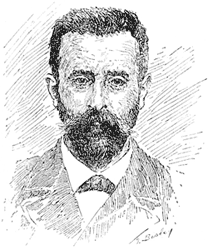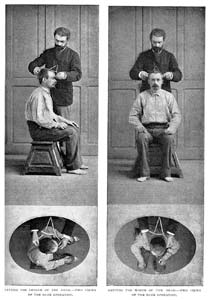






"I had hardly expected so dolichocephalic a skull or such well-marked supra-orbital development. Would you have any objection to my running my finger along your parietal fissure? A cast of your skull, sir, until the original is available, would be an ornament to any anthropological museum. It is not my intention to be fulsome, but I confess that I covet your skull." Mortimer means that Holmes has a long head and a developed forehead. He would like to run his finger along the top of Holmes's head, where the bony plates join. His terminology comes from phrenology, a 19th-century, pseudo-scientific practice, which held that the qualities of intelligence and personality could be read from the shape of the brain, and therefore from the shape of the skull. Various parts of the brain were considered to be the seat of certain qualities, functions, or passions. Today, we know this to be true, but the phrenological map was almost completely inaccurate, and its practice was spurious. By Conan Doyle's time, phrenology had passed out of serious consideration as a science and into the realm of "common knowledge."
"To the man of precisely scientific mind the work of Monsieur Bertillon must always appeal strongly." "Then had you not better consult him?" Alphonse Bertillon (1853-1914), French police official and pioneer in forensics and identity science, invented the "mug shot" and developed anthropometry, a system of bodily measurements meant to reliably identify individuals. This system, never foolproof, was replaced by fingerprinting, which, in turn, is slowly being replaced by DNA testing. The most famous illustration of the weakness of Bertillon's system is the story of Will West and William West, two inmates incarcerated at Leavenworth in 1901 and 1903, who had identical measurements and nearly identical names. Their fingerprints, however, were different. Holmes is right to resent the comparison. Bertillon is infamous for being the handwriting "expert" whose inaccurate testimony convicted Captain Alfred Dreyfus for treason in 1894. |
||||||
Copyright ©
2006 Stanford University. All rights reserved. Stanford, CA 94305, (650)723-2300
l Terms
of Use

